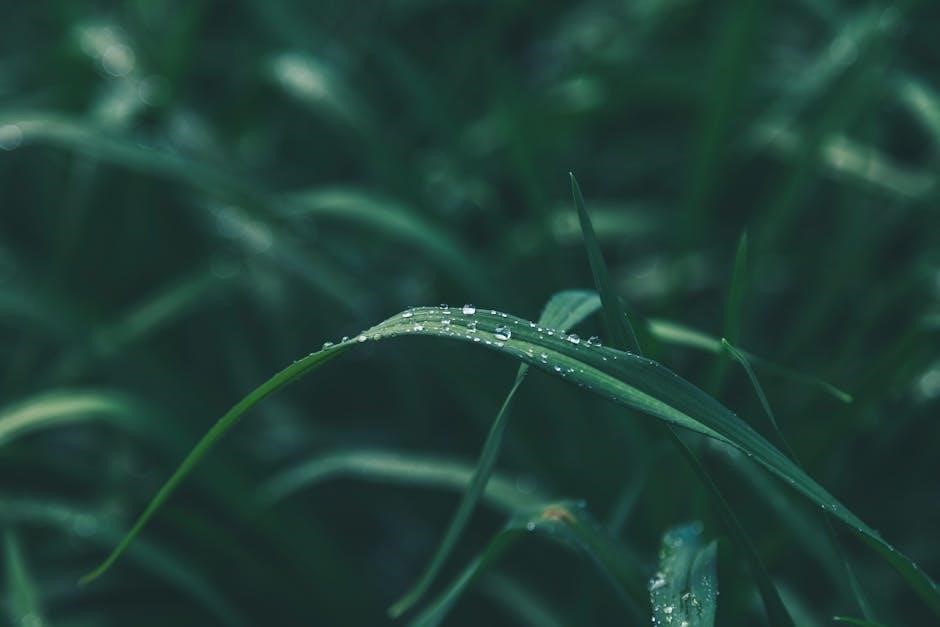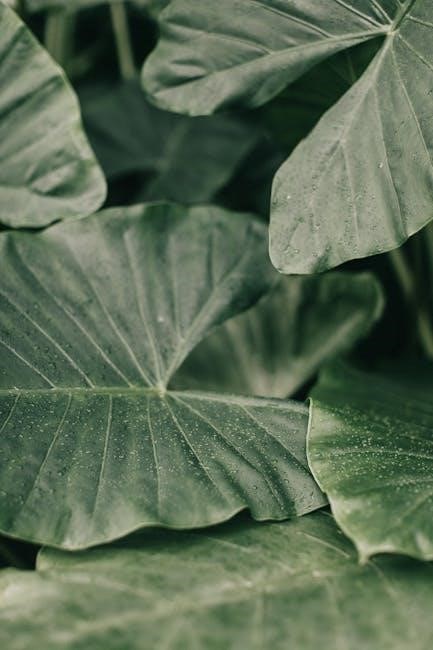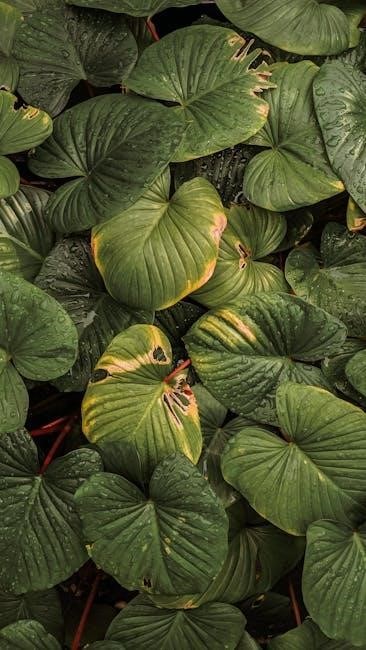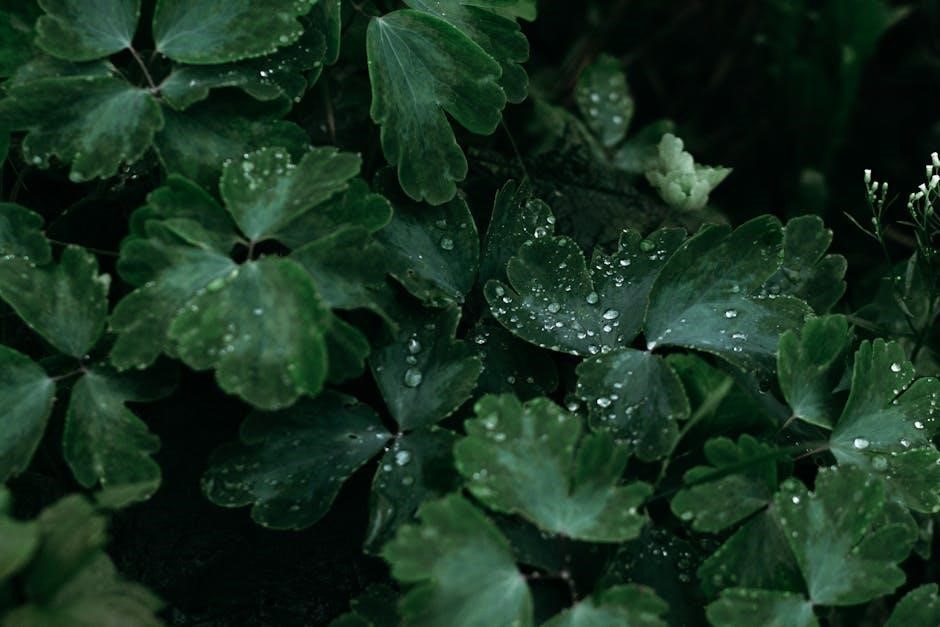Understanding the Importance of Soil Moisture for Plant Health
Soil moisture is critical for plant health, as it directly affects photosynthesis, root development, and nutrient uptake. Proper water levels prevent root rot and ensure healthy growth.

How Soil Moisture Affects Plant Growth
Soil moisture plays a vital role in plant growth by regulating water availability, which is essential for photosynthesis, nutrient transport, and root development. Proper hydration ensures healthy cell turgidity and metabolic processes. Overwatering can lead to root rot and oxygen deprivation, while underwatering stresses plants, reducing growth and productivity. Balanced soil moisture supports robust root systems, enabling plants to absorb nutrients efficiently. It also maintains soil structure, preventing erosion and ensuring optimal conditions for microbial activity. Monitoring soil moisture helps gardeners avoid extremes, fostering a healthy environment for plants to thrive and achieve their full growth potential.
The Risks of Overwatering and Underwatering Plants
Overwatering disrupts root function, causing rot and oxygen deprivation, which can lead to plant death. It also fosters harmful pathogens, damaging plant health. Underwatering stresses plants, slowing growth by limiting nutrient uptake and photosynthesis. Both extremes harm soil structure and microbial balance. Using a moisture meter helps avoid these risks, ensuring optimal hydration levels. It provides precise readings to guide watering decisions, preventing root rot and nutrient deficiencies. Accurate moisture monitoring is crucial for maintaining healthy plants and maximizing growth potential.

What is a Moisture Meter for Plants?
A moisture meter is a tool that measures soil moisture levels, helping gardeners determine when to water plants. It ensures optimal hydration for healthy growth.
Definition and Basic Functionality
A moisture meter for plants is a device designed to measure the water content in soil. It typically consists of a probe inserted into the soil, which detects moisture levels. The probe is usually made of metal and relies on electrical conductivity to provide readings. Some meters also measure light and pH levels. The device helps gardeners avoid overwatering or underwatering by giving a clear indication of soil conditions. Moisture meters are simple to use, requiring minimal setup, and provide quick, accurate readings to ensure optimal plant hydration and health. They are essential tools for both novice and experienced gardeners.
Types of Moisture Meters (Analog vs. Digital)
Moisture meters for plants are available in two primary types: analog and digital. Analog meters use a dial or needle to indicate soil moisture levels, providing a visual representation. Digital meters, on the other hand, display precise numerical readings, often with additional features like pH or light measurement. Analog meters are simple, non-electric, and battery-free, making them easy to use. Digital meters offer greater accuracy and convenience, especially for those who prefer clear, instant readings. Both types are effective, but the choice depends on personal preference and the level of detail needed for plant care.
How to Use a Moisture Meter Effectively
Insert the probe into the soil without touching the plant base, ensuring accurate moisture readings. Check the meter’s mark to determine the wetted soil depth effectively.
Step-by-Step Guide to Inserting the Probe
First, locate the plant’s base to avoid damaging roots. Gently push the probe into the soil at a slight angle until the tip reaches the root zone. Ensure it’s fully inserted but not touching any plant structures. Hold the meter steady and wait for the dial to stabilize. This ensures an accurate reading, reflecting the soil’s moisture levels without interference from surrounding elements. Proper insertion is key to reliable results, helping you make informed watering decisions for your plants’ health and vitality. Avoid over-tightening to prevent soil compaction, which can affect water absorption and root growth. Regularly clean the probe to maintain accuracy and prevent residue buildup that might skew readings. By following these steps, you’ll optimize your moisture meter’s performance and ensure your plants receive the right amount of water every time. This method not only simplifies plant care but also enhances the overall well-being of your plants by eliminating guesswork in watering schedules.
How to Interpret the Readings
Understanding the moisture meter readings is essential for proper plant care. Most meters display moisture levels on a scale, with 1 indicating dry soil and higher numbers showing increased moisture. A reading of 2-3 typically signifies optimal conditions for most plants, while a reading above 4 suggests overwatering. If the meter shows a low value, it’s time to water. Conversely, high readings indicate the soil is already saturated. Adjust watering schedules based on these insights to maintain balanced soil moisture, ensuring healthy root growth and preventing waterlogged soil. This data helps you make precise decisions tailored to your plants’ needs. Always consider plant species and soil type when interpreting readings, as some plants prefer drier or wetter conditions; By consistently monitoring and adjusting, you’ll create an ideal environment for your plants to thrive. For example, if the meter consistently reads above 4, it may signal overhydration, while a reading below 2 indicates the soil is too dry. Use this information to fine-tune your watering routine and ensure your plants receive the right amount of moisture for optimal health. Regularly checking the meter will help you avoid common pitfalls like underwatering or overwatering, both of which can stress plants and hinder growth. By interpreting the readings correctly, you can maintain a balanced moisture level that supports robust plant development and prevents root-related issues. This approach not only enhances plant health but also promotes efficient water use, making it a sustainable and effective method for gardeners of all levels.

Factors to Consider When Choosing a Moisture Meter
Key factors include accuracy, durability, and ease of use. Consider probe length, battery requirements, and cost-effectiveness. Ensure the meter suits your plant type and soil conditions for reliable results.
Key Features to Look For

When selecting a moisture meter, prioritize accuracy and durability. Look for a long, sturdy probe that can reach deep into the soil without bending. A battery-free design eliminates maintenance hassles. Opt for a meter that measures multiple parameters, such as moisture, light, and pH, for comprehensive plant care. Ensure the device is easy to read and provides consistent results. Consider cost-effectiveness and whether it suits your specific plant types and soil conditions. Advanced features like smart sensors or IoT compatibility can enhance functionality for tech-savvy users, while simple analog meters are great for basic needs.
How to Ensure Accuracy and Reliability
For precise readings, calibrate your moisture meter regularly and follow the manufacturer’s instructions. Insert the probe to the recommended depth to avoid inaccurate measurements. Avoid touching the probe tip to plant roots or debris, as this can skew results. Ensure the soil is settled around the probe for consistent readings. Clean the probe after each use to prevent contamination. Store the meter in a dry place to maintain its sensitivity. Regularly compare meter readings with manual soil checks to verify accuracy. Proper care and usage will ensure your moisture meter remains a reliable tool for plant care.

Tips for Maintaining and Calibrating Your Moisture Meter
Regularly calibrate your moisture meter and clean the probe to ensure accuracy. Store it in a dry place to maintain effectiveness. Avoid submerging in water to prevent damage. Check for any debris or corrosion on the probe and replace it if necessary. Follow the manufacturer’s instructions for calibration and maintenance. Proper care will extend the life of your meter and ensure reliable readings for healthy plant growth.
Best Practices for Long-Term Use
To ensure your moisture meter remains accurate and reliable, clean the probe after each use and store it in a dry place. Avoid exposing it to extreme temperatures or chemicals. Regular calibration is essential to maintain precision, especially if you notice inconsistent readings. Replace worn or corroded parts promptly to prevent damage; For long-term use, consider investing in a durable, high-quality meter with a sturdy probe. Following these practices will extend the life of your meter and ensure consistent, accurate readings for optimal plant care.
How to Troubleshoot Common Issues

If your moisture meter shows inconsistent readings, check for probe damage or corrosion. Clean the probe with a soft cloth and water; Ensure proper insertion depth and avoid touching nearby objects, which can interfere with accuracy. If readings remain off, recalibrate the meter according to the manufacturer’s instructions. For digital meters, replace batteries if low power affects performance. Store the meter in a dry place to prevent moisture buildup. Addressing these common issues promptly will ensure reliable results and extend the meter’s lifespan, helping you maintain optimal watering practices for your plants.

Advanced Techniques for Optimizing Plant Care
Combine moisture meters with pH and light sensors for comprehensive plant monitoring. This integrated approach ensures balanced nutrition, optimal watering, and tailored environmental adjustments for thriving plants;
Using Moisture Meters in Combination with Other Tools

Combining moisture meters with pH sensors and light meters provides a holistic view of soil and plant conditions. This integrated approach ensures balanced nutrition and optimal watering. Advanced tools like smart sensors enable real-time monitoring, while IoT integration automates adjustments for precise care. By syncing moisture data with temperature and light readings, growers can fine-tune environments, preventing overwatering and ensuring plants thrive. This multi-tool strategy enhances accuracy and simplifies plant maintenance, making it ideal for both indoor and outdoor gardening. Together, these tools create a comprehensive system for modern, data-driven plant care.
How to Adjust Watering Schedules Based on Meter Readings
Adjust watering schedules by monitoring moisture meter readings to avoid overwatering. When readings indicate dry soil, water thoroughly. If readings show moisture, delay watering. This method ensures plants receive the right amount of water, promoting healthy growth and preventing root rot. By tracking changes in soil moisture over time, you can tailor watering frequencies to specific plant needs and environmental conditions. Consistent monitoring helps maintain optimal soil moisture levels, enhancing plant health and productivity while reducing water waste. Regular adjustments based on meter readings ensure a balanced watering routine for all plants.
Future Trends in Soil Moisture Monitoring
Future trends include smart sensors and IoT integration, enabling real-time soil moisture monitoring and automated watering adjustments for precise plant care and resource efficiency.
Smart Sensors and IoT Integration
Smart sensors and IoT integration revolutionize soil moisture monitoring by enabling real-time data collection and remote monitoring via smartphones. These devices automatically adjust watering schedules based on sensor readings, ensuring optimal hydration. IoT-connected meters use Wi-Fi or Bluetooth to send alerts when moisture levels drop, preventing overwatering. Advanced systems integrate with irrigation controllers, automating water delivery. Big data analytics and AI further enhance accuracy, offering personalized recommendations. This technology promotes energy efficiency and reduces water waste, making plant care smarter and more sustainable. IoT-enabled meters are particularly valuable for large gardens or commercial agriculture, ensuring precise monitoring and care.
The Role of Technology in Modern Plant Care
Technology has transformed plant care by providing innovative tools for precise monitoring and automation. Smart sensors, IoT devices, and moisture meters enable real-time tracking of soil conditions, light, and temperature. Apps offer personalized recommendations, while automated irrigation systems optimize water usage. Data analytics and AI predict plant needs, reducing guesswork. These advancements make plant care more efficient, sustainable, and accessible, even for beginners. Technology empowers gardeners to create ideal growing conditions, ensuring healthy, thriving plants with minimal effort and resource waste.
